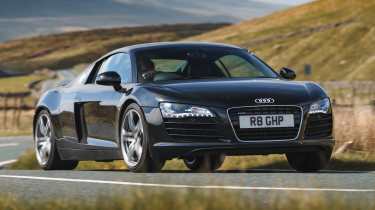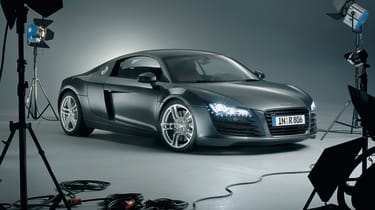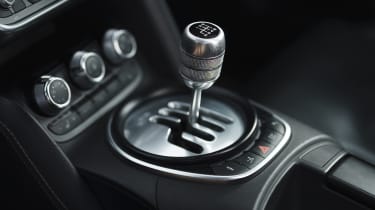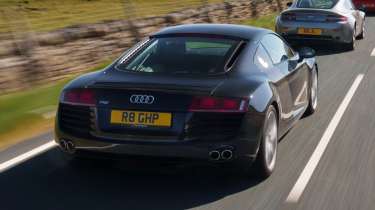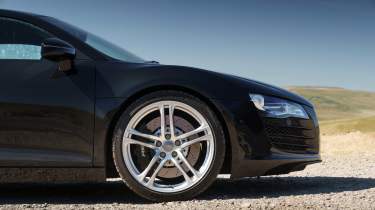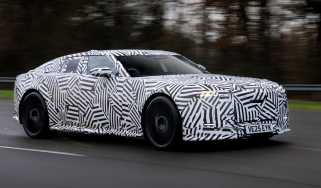Audi R8 V8 (2007 - 2015) review – the Porsche 911’s equal is a bargain super sports car
The Audi R8’s launch was perhaps one of the biggest moments in 2000s performance motoring. It’s as sweet today as back then
The Audi R8 is one of those cars whose impact sticks in the memory. Though the anticipation ahead of its 2006 arrival was palpable, no one expected that Ingolstadt’s first super sports car would be resolved to a Porsche 911-beating standard straight out of the gates. It was a simply unprecedented effort, breaking dynamic and stylistic ground left untouched by its established rivals.
The R8 duly hit the super sports car and supercar market with a transformative impact akin to that of the iPhone on the mobile telephone market. Even without the kudos of being Iron Man’s company car, its styling was of the moment (it’s aged well too) and the driving experience fully delivered.
With a sweet balance, an even sweeter engine and bonafide highstreet-stopping supercar style, there wasn’t much the original R8 couldn’t do. The magic wasn’t just due to the whirlwind of hype around the shiny new thing, as we’ve come to discover in latterday encounters, revisiting it as an evo Icon and most recently, with its inclusion in our evo Eras: the 2000s test. To this day it remains a simply outstanding car and high watermark of what was an astonishing decade for performance cars.
History
Covering the R8’s development genesis in evo 081 – coverline ‘Look out Porsche!’ – Harry Metcalfe related the pivotal meeting on Friday, April 22, 2005, when Professor Winterkorn and Dr Pischetsrieder met their fellow Audi board members to decide whether to green-light a production version of the mid-engined Le Mans quattro concept car (a celebration of the marque’s 2000, 2001 and 2002 on-the-trot 24-hour wins) designed by Frank Lamberty and Julian Hoenig and first seen at the 2003 Geneva show.
More reviews
After a day driving V8-engined prototypes built around the modified core structures of the first-generation Lamborghini Gallardo, the relevant bosses had no qualms in pressing the button and vowed to fast-track what was assumed to be the R9. In its transition from concept to production car, the R9 was renamed R8, thereby nicking the badge from the successful LMP1 racer, which by the time of the road car’s 2006 reveal, had racked up a further two Le Mans victories before deferring to the R10 TDI for 2006.
Following the success of the original V8-engined R8 launch Audi quickly iterated, with the V10 arriving in short order, followed by Spyder versions and a hardcore GT. A facelift arrived in 2012, finally fixing the R8 lineup’s weak point, swapping the R-tronic seven-speed transmission for Audi’s dual-clutch S-tronic. The V10 Plus was soon added to the lineup as the most powerful R8, pushing the model upward, dangerously close to the Gallardo’s neck of the market. The LMX with its revolutionary laser lights was as good as a second-gen GT and saw out the first generation R8 in 2014.
The Gallardo’s V10 was slated to be added as a later option from the outset. Some more wild ideas were never carried to fruition, namely shoehorning in the Group’s 6-litre W12 and even a diesel V12 inspired by the R10 and R15 prototypes that took over from the R8’s namesake at Le Mans (cripes!). Cooler heads prevailed in favour of retaining the R8’s focus.
Engine, gearbox and technical highlights
Details were sketchy back in 2005, but Harry correctly divined that the new mid-engined, four-wheel-drive junior supercar would be built at Audi’s Neckarsulm plant, where the company’s pioneering aluminium engineering expertise (A2, A6, A8) resided. More relevant still, in light of the tight timetable, the Gallardo’s aluminium sub-structure and body panels were also fashioned there before being packed off to Sant’Agata for final assembly. No detective work required, then, as to what would lie beneath the final iteration of the revolutionary Audi’s sleek form, finally manifested as the Audi Space Frame.
Helpful, of course, that Audi’s sporting subsidiary, then called quattro GmbH, was also based at Neckarsulm, where it had previously developed the RS4 and therefore could quickly fit a dry sump to an otherwise ‘oven-ready’ naturally aspirated 4.2-litre, direct-injected V8 with 414bhp, to slot into the carbon cradle reworked from the Gallardo’s.
Not that the production R8 had anything of the crisply angled Lambo about it. Gratifyingly, it emerged looking almost exactly the same as the stunning Le Mans quattro concept. Talking to Harry, Stephen Reil (general manager of development at quattro GmbH) said: ‘You’d have to be an Audi designer to spot the difference between them.’ A slight exaggeration, but the R8 was as close to its show star progenitor as concept-spawned production cars ever get.
If the job of the R8 was to be Audi’s new icon, it couldn’t go without a quattro drivetrain, albeit one with 30 per cent of the torque going to the front and 70 per cent to the rear – the same split as the all-drive Gallardo. With the 4.2-litre FSI V8 developing 414bhp and giving a power-to-weight ratio of 270bhp per ton, the projected performance figures ran 0-60mph in the mid-4s, 100mph in a little over 10sec and 0-125mph in around 15sec, the R8 going on to a top speed of 177mph. The sprinting stats turned out to be pretty spot-on but the top speed fell 10mph shy of what the production R8 eventually recorded. In a world where a lot of high-performance German metal was limited to 155mph, simply read ‘very fast’.
No great fan of paddleshift transmissions, Reil championed a manual for the R8 roll-out, with an R-tronic single-clutch automated manual to follow at a later date. Thank heavens he did. The resulting open-gate, six-speed gearbox swiftly became a defining element of the car, subverting the idea that a good-looking ‘scrape-clack’ affair, which no self-respecting Italian exotic had been without for decades, was tricky to master by engineering a smooth and sublimely satisfying shift quality to rival that of any car on the planet.
> Lamborghini Murciélago (2001 - 2011) review – an unadulterated supercar icon
It brilliantly encapsulated what the R8 was about: pure supercar visuals and sensations unsullied by compromises, awkwardness and quirks. The R-tronic of course became an option and was the weak point across the entire R8 range, being eventually replaced by the dual-clutch S-tronic transmission when the time for a facelift came.
A priority from the start was useability. A 2+2 configuration was initially mooted, not inconceivable as the R8’s wheelbase was 90mm longer than the Gallardo’s, but soon dropped in favour of a spacious two-seater layout with a sizeable bench behind the seats to augment the deep but rather narrow boot in the nose. A key optional extra on the R8 was its magnetic ride suspension, which used dampers filled with magnetised fluid that could be controlled in terms of stiffness and softness. These afforded the R8 a wide breadth of damping capability and adaptability.
Driving the Audi R8
‘Back in the summer of 2007 we’d convened in the south of France, specifically at a hotel owned by Bernie Ecclestone near the Paul Ricard circuit, predictably nicknamed Bernie’s Inn. Audi’s chosen venue for the European launch of its first ever mid-engined road car had a conveniently long parking rank right outside, all the better to fill with pristine R8s, not so subtly multiplying the impact of the new car’s futuristic shape and signature ‘blades’. Parking a BMW M6 (E63), an Aston Martin Vantage (with Prodrive upgrades) and, yes, a Porsche 911 (997 Carrera 4S) on the end of one of the rows would rather have spoiled the effect, never mind given away our intention to introduce the R8 to some notably fit, fierce and talented friends.
‘I came to a pretty stark conclusion in evo 106: “Purity of purpose and breadth of ability win the day and no car here – probably none under £100k – expresses the fusion more perfectly than the R8. There are faster supercars but we can’t think of another currently in production that takes a demanding road apart with quite the surgical precision and cool-browed composure of Audi’s hugely desirable R8. The outcome we doubted we’d ever witness. Audi humbles Porsche.”
‘The V8-engined car goes all the way from relaxingly anodyne – a smooth, low-energy state further massaged by an outstandingly supple ride – to properly awake and arcing excitement on a beautifully linear trajectory to the 8250rpm red line, the final 2000rpm supported by a creamy, hollow howl from induction and exhaust.
‘It forms a kind of constantly fulfilling feedback loop, comfortably the right side of sanity: just enough thrust to widen your eyes, just enough aural stimulation to keep your toe heading downwards. You might not go any faster than a Volkswagen Golf R, but the experience will be one to savour long after you’ve parked up and walked away.’ – David Vivian, writer of the evo 106 ‘New order’ cover story and Icon: Audi R8, evo issue 284.
‘Every time I get into an original V8 manual I come to the same conclusion. It’s sublime, it’s the one.This car is in fantastic condition with just 24k miles on the clock and drives like new. The gearshift is super-slick, snicking easily around the open gate, and the V8 engine delivers more than enough performance, the revs soaring with a brush of the throttle, full power delivered with real character and a hunger.
‘But the real star is the chassis; this thing has poise by the truck-load. It’s extraordinarily well sorted, the damping (MagneRide on this car, which expands the scope of the ride) is exquisite and it has a depth of quality that makes even the fabulous E46 M3 feel a bit thin.
It is interesting to note that for the same £40k you could have an exceptional, very low miles V8 Vantage, a pretty average 911 Carrera S or an immaculate, low miles V8 R8…’ – John Barker, evo editor-at-large, evo Eras: the 2000s test.
Audi R8 values and buying guide
How they’ve endured is a testament to Audi’s astonishing achievement with the car in period. This is no sensitive supercar, rather a sturdy driving device that largely stands up to the near two decades of life they’ve been subject to. That said, they’re not infallible. In the R8 as in the RS4, the 4.2-litre FSI engine is a regular for timing chain issues – a substantial job to replace given that the end of the engine is pressed against the firewall.
The R-tronic single-clutch transmissions, also eat their clutches as any other automated manuals of the era do. Perhaps the R8’s most peculiar wear point is in its drivetrain. R8s are very sensitive to tyre choice – they need to match, yes in terms of make and model but also in terms of wear, to avoid undue wear on the differentials. It goes without saying, your choice of R8 should be one with a substantial history of maintenance from dealers or reputable model specialists.
That last part is important given the relative low values of R8s given the style and substance they offer. Being an affordable supercar, many have passed through hands that haven’t been diligent in maintaining them, so choose carefully and know your car’s history.
The V8 manual is the R8 of choice and cars do exist for under £30k. As above, maintenance history is essential, making even higher mile cars preferable compared to cars with low miles that haven’t been looked after. Really nice, perfect history manuals aren’t excessive, barely clearing £50,000. We don’t expect this to be the case for long.
Audi R8 4.2 FSI quattro specs
| Engine | V8, 4163cc |
|---|---|
| Power | 414bhp @ 7800rpm |
| Torque | 317lb ft @ 4500rpm |
| Weight | 1560kg |
| Power-to-weigh | 270bhp/ton |
| 0-60mph | 4.4sec |
| Top speed | 187mph |
| Price when new | £78,195 |
| Value today | £30,000-60,000 |
